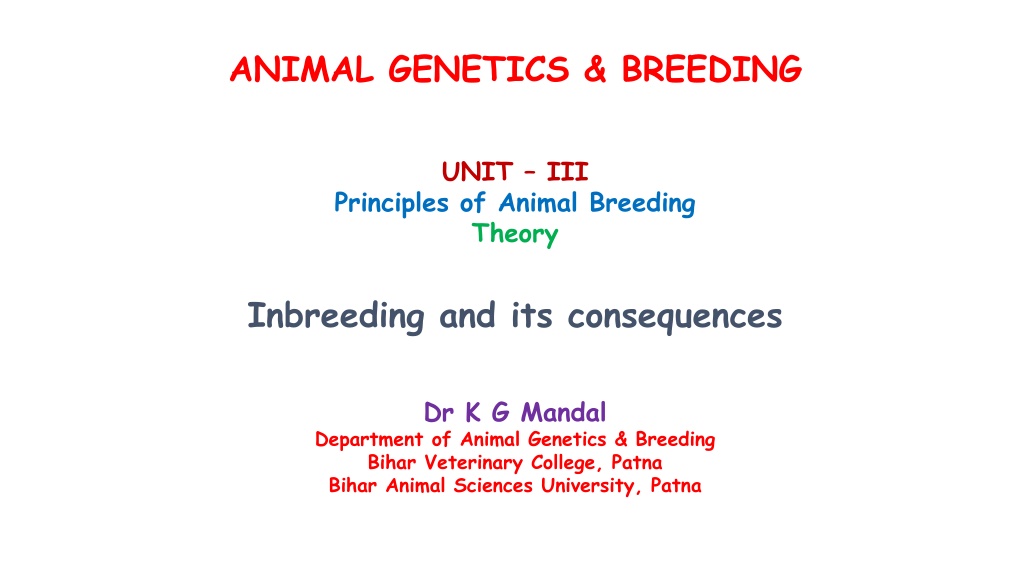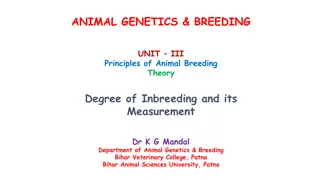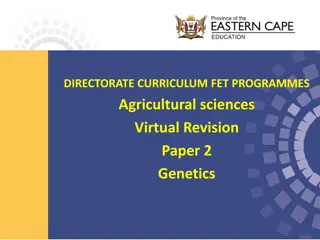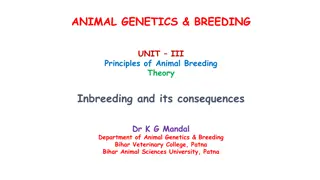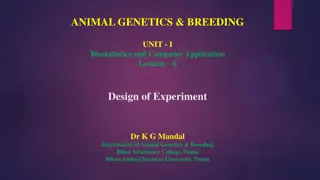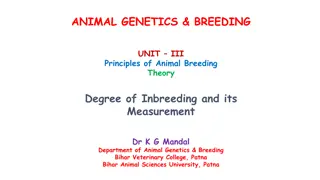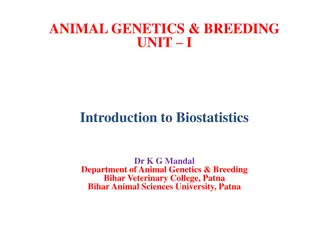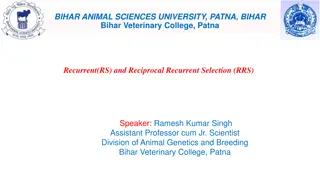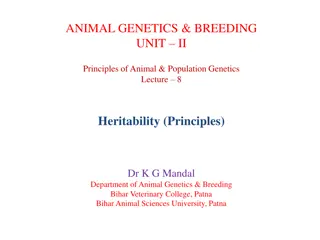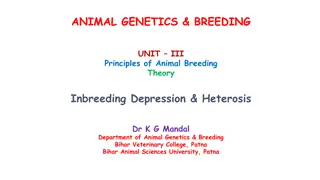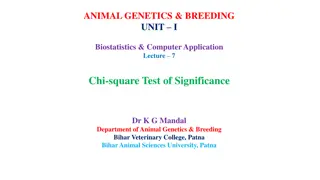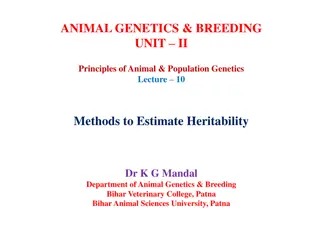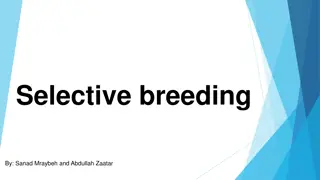Understanding Inbreeding and Its Consequences in Animal Genetics & Breeding
Inbreeding in animal breeding involves mating closely related individuals, resulting in common ancestors within the preceding generations. This practice can have both positive and negative consequences on genetic diversity and health. Various types of inbreeding such as selfing, full-sib mating, and parent-offspring mating are classified based on the degree of relatedness. Pedigree records play a crucial role in estimating breeding value, facilitating selection, and formulating breeding plans. Visual diagrams illustrate the patterns of inbreeding, showcasing the transmission of genetic material through different mating strategies.
Download Presentation

Please find below an Image/Link to download the presentation.
The content on the website is provided AS IS for your information and personal use only. It may not be sold, licensed, or shared on other websites without obtaining consent from the author. Download presentation by click this link. If you encounter any issues during the download, it is possible that the publisher has removed the file from their server.
E N D
Presentation Transcript
ANIMAL GENETICS & BREEDING UNIT III Principles of Animal Breeding Theory Inbreeding and its consequences Dr K G Mandal Department of Animal Genetics & Breeding Bihar Veterinary College, Patna Bihar Animal Sciences University, Patna
Inbreeding: Mating of individuals which are more closely related to each other than the average relationship of the population concerned. Related individuals: Two individuals are said to be related if they have common ancestor in the preceding 4 6 generations of their pedigree. Ancestor: An individual which transmits its genetic material to the descendants. Descendant: An individual who receives some of its genetic material from the ancestor.
Common ancestor: Individual who transmits its genetic materials to the inbred through sire s and dam s pedigree of the inbred individual is known as common ancestor. Inbred: The individual which is produced by mating of relatives is known as inbred. Pedigree: Systematic list of all ancestors to which an individual is genetically related. Application of pedigree: (i) To estimate breeding value based on pedigree record. (ii) To facilitate early selection based on pedigree record. (iii) To estimate genetic parameter (iv) To formulate breeding plan
Inbreeding: Example : (i) Selfing (ii) Full sib mating (iii) Half-sib mating (iv) Parent-offspring mating (v) Mating of cousin brother sister, etc. Classification of Inbreeding : 1. Close breeding: Mating of more closely related individuals. Example: (i) Selfing the closest form of inbreeding (ii) Parent offspring mating (iii) Full-sib mating
Diagrammatic presentation of close breeding Full-sib mating: S X D Parent offspring mating: A B Where, X = Offspring S & D = Full-sibs A & B = Parents S (sire) (offspring) X D (daughter) ( Arrow diagram showing pedigree of inbred individual X)
Bracketed diagram showing full-sib mating: A S B X A D B
Arrow diagram showing continuous full-sib mating: S 1 A X D 2 B Direction of arrow indicates flow of genetic material. X is an inbred offspring produced by mating of full-sibs S & D. S & D are produced by mating of another full-sibs 1 & 2.
2. Line breeding: attempt is made to increase the frequency of superior genes of an outstanding ancestor among the inbreds of future generations. Example : (i) Half-sib mating S X D Where, X = inbred offspring produced by mating of half- sibs S & D. A is the common ancestor which transmitted the genetic material to the inbred individual X through S & D. It is a form of inbreeding in which an A
(ii) Mating of a sire continuously with its daughter, grand daughter, grate grand daughter, and so on, so that superior genes of an outstanding sire persist among the progeny. S (sire) D (dam) Where, d3 d2 d1 (Daughter) d2 = grand daughter d3 = great grand daughter
(iii) Mating of cousin brother and sister: A B. 1 2 ( 1 & 2 Full-sibs) S D (S & D cousin brother & sister) X (X is an inbred individual)
Genetic consequences of inbreeding: 1. Increases homozygosity in the population at the cost of heterozygosity. 2. It does not change the gene frequency in the population. 3. All pairs of genes that segregate independently are made homozygous at the same rate. 4. The rate of inbreeding in case of animals is much slower than the plants. 5. Inbreeding causes fixation of genes in the inbred line.
Genetic effect of inbreeding can be illustrated with the following example considering a pair of alleles D & d : Assumption: 1. Dealing with self fertilized plant. 2. There is no selection for or against the dominant or recessive gene. 3. Parent generation contains 1600 individuals and are heterozygous for the same pair of genes.
Illustration: Generation Genotypes % Gene frequency homozygotes DD 0 400 400 + 200 700 Dd 1600 800 400 dd 0 400 600 D d 0 1 2 0 0.5 0.5 0.5 0.5 0.5 0.5 50.0 75.0 3 200 700 87.50 0.5 0.5
General consequences of inbreeding : 1. Inbreeding increases homozygosity. 2. It does not change the gene frequency. 3. Inbreeding results into expression of hidden recessive genes in the population by making theme homozygous. 4. Inbreeding fixes characters in an inbred population.
5. Inbreeding causes inbreeding depression. Decreasing in mean phenotypic value of the characters associated with fitness, reproduction and physiological efficiency due to inbreeding is known as inbreeding depression. 6. Inbreeding increases prepotency. Prepotency is the ability of an individual to stump of its characteristics to its progeny so that progeny resemble the parents.
Use of inbreeding : 1. To determine the genetic worth of an individual. 2. It is practiced for selection against a recessive gene. 3. It is used to form different families and strains of lab animals. 4. Inbreeding combined with selection over a period of time results into development of new breeds. 5. It is used for production of prepotent animals. 6. The most important use of inbreeding is the production of inbred lines.
Disadvantage: 1. Inbreeding increases the frequency of undesirable traits in the population. 2. It exposes lethal and sublethal genes by making them homozygous. 3. The traits related to fitness (survivability, reproduction and physiological efficiency) and vigour are reduced in farm and laboratory animals.
